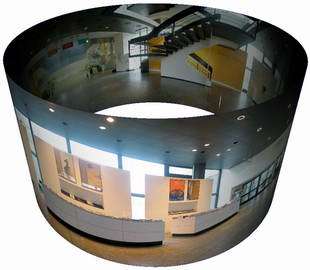Interactive virtual showroom

In cylindrical 360° panoramas, virtual scenes can be viewed all the way around their own axis. A new system now allows these scenes to be explored interactively by augmenting them with sound, pictures or films, creating living representations of enclosed spaces.
Who hasn’t gone on a shopping spree only to end up wishing they could just toss line-jumping customers out of the store, instantly conjure up a knowledgeable salesperson, and switch off the annoying din blaring from the speakers? This scenario could soon be possible, at least in a virtual sense.
Researchers at the Fraunhofer Institute for Telecommunications HHI in Berlin have expanded on a system that can display real environments as high-resolution 360-degree panoramas rather than simply on two-dimensional monitors. Videos, moving or stationary objects, and sound can be embedded in the display.
Vendors can demonstrate various products in a virtual showroom, or provide links to product information. “In this way, the customer can interactively create a personalized shopping atmosphere among the goods that are on show,” says Peter Eisert. "Furthermore, he can filter out products that are not of interest, retrieving info on individual products, and determining how many other customers will share this space."
Videos can be used to generate the virtual environment, but so can simple digital camera photos. In order to have more flexibility in processing the raw data, the HHI researchers developed various algorithms for the subsequent optimization process. If for example the user just wants to be surrounded by a bustling scene, the program can use multiple images to generate moving cars or people. Another algorithm corrects brightness disparities by taking images with dissimilar exposure times and creating new images with all of the elements properly lighted. The multimedia standard MPEG-4 BIFS (Binary Format for Scenes) specifies the architecture for the panoramas. It treats the embedded image, sound or film data as individual objects that can be processed singly and later individually selected with the user’s mouse. Computer scientists also use this standard for streaming. To keep the data rate low, only the elements required for the user’s current point of view are transmitted.
Virtual showrooms represent only one potential application for the new technology. “Tour operators could use them to show a vacation resort to prospective customers – letting them make sure that the pool isn’t twenty meters away from the highway, for instance,” suggests Eisert. At CeBIT trade fair visitors may explore different scenes in Hall 9, Stand B36: the Brandenburg gate, the famous Adlon hotel and the ethnological museum in Berlin-Dahlem to learn more about its exhibits.















